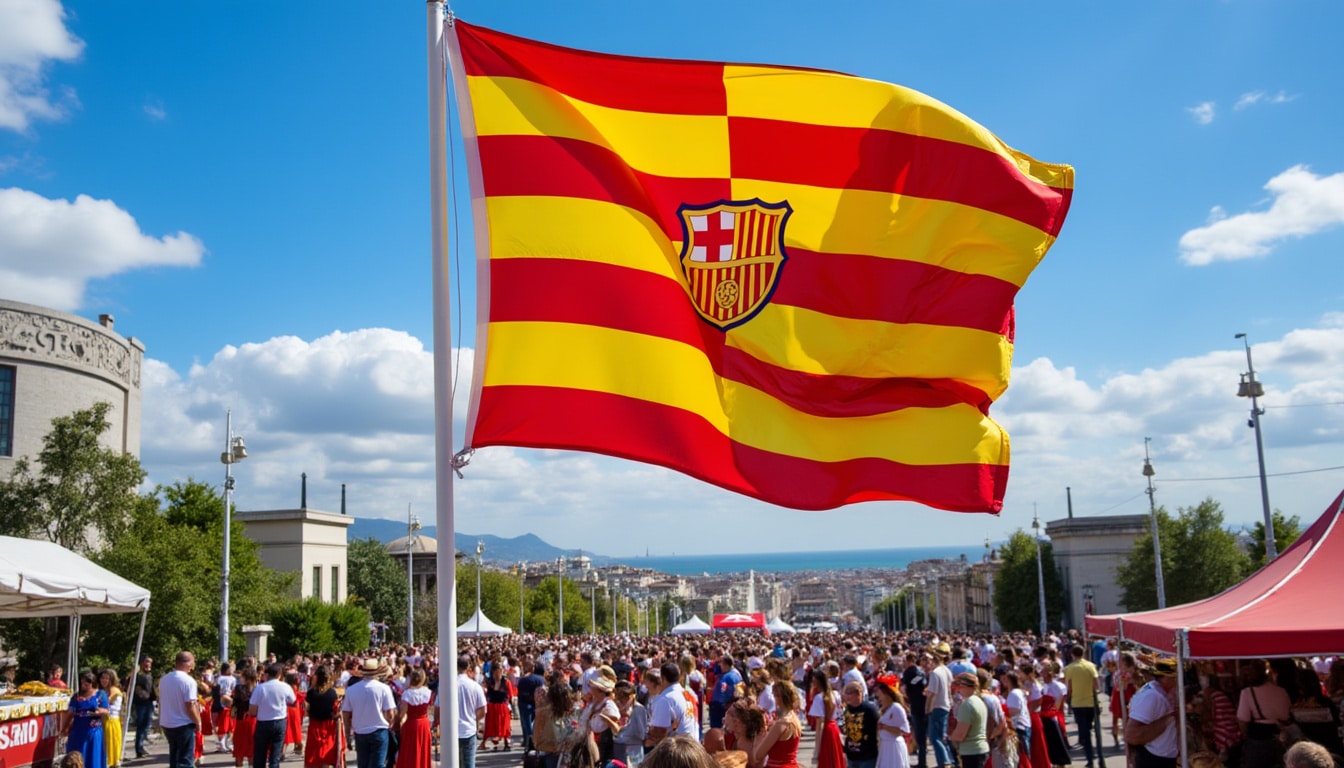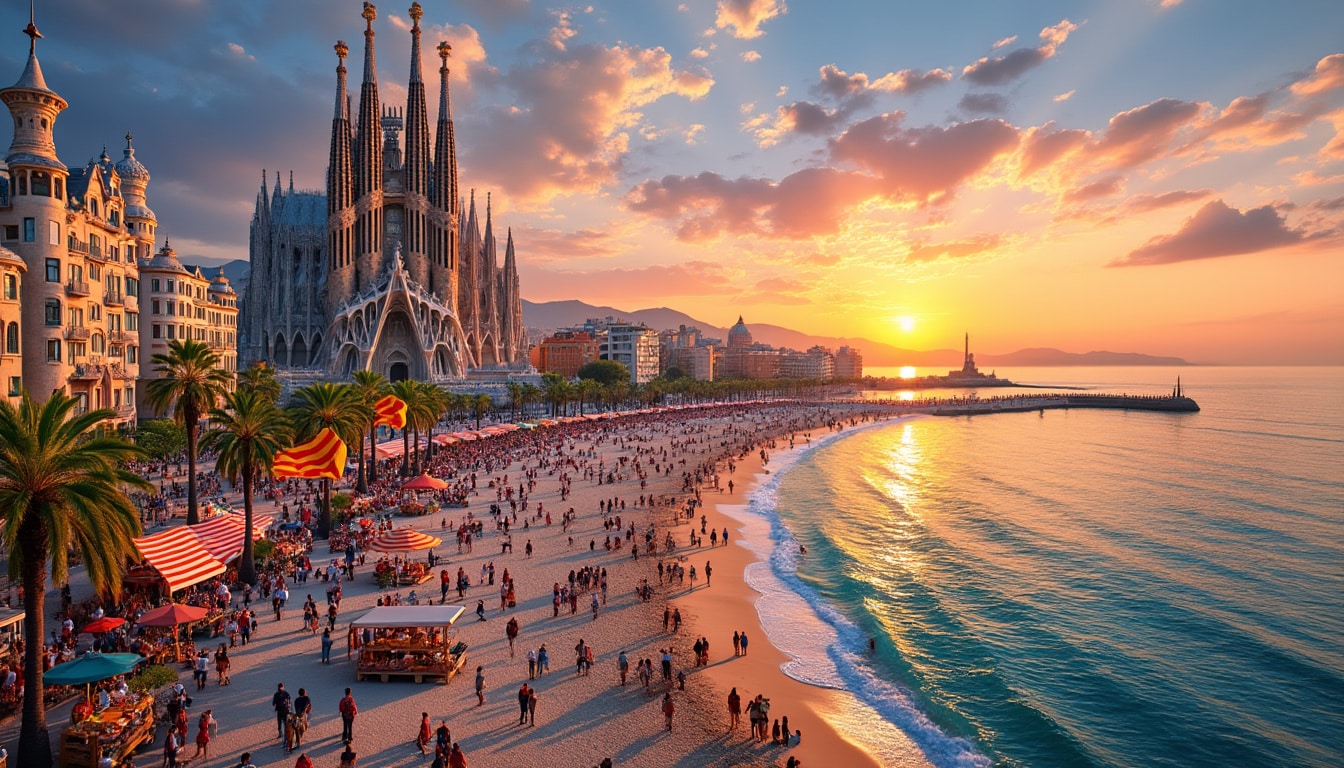Barcelona, a city renowned not only for its architectural marvels and vibrant culture but also for its rich tapestry of history and symbolism, has long stood as a beacon of Catalan identity. This distinct identity is woven intricately into the names, flags, and symbols that define the city. Discover the multifaceted identity of Barcelona—through its renowned Senyera flag, its diverse names, and the deep-rooted cultural significance that these hold for locals and visitors alike.
The Historical Essence of the Barcelona Flag
The Barcelona flag, a symbol of pride for the Catalan people, carries a rich historical essence that echoes through the centuries. Known commonly as the Senyera, this flag speaks volumes about the city’s legacy and its ties to the Crown of Aragon.
Dating back to the 11th century, the Senyera’s design—a resplendent mix of four red stripes against a yellow backdrop—originates from its role as the royal standard of the Crown of Aragon. The red hues represent the counties like Girona, Lleida, and Tarragona, uniting under Barcelona, while embodying courage and valor. In contrast, the yellow background depicts wealth and prosperity, reflecting Catalonia’s historical ties to trade and commerce.
The significance of the Senyera extends beyond its aesthetic; it forms a pivotal part of Barcelona’s cultural identity. Local celebrations and sporting events like LaLiga feature the flag prominently, bolstering the communal spirit. FC Barcelona fans, who cherish the club’s deep-seated local roots, unfurl the flag with pride during matches.
- ⚔️11th century origins
- 🏛️Royal Standard of the Crown of Aragon
- 🎨Symbolizes courage and wealth
- ⚽Associated with FC Barcelona

In recent years, the Senyera has intertwined itself within political movements, standing as a potent symbol for Catalan independence. The desire for self-determination and sovereignty has seen the flag at the forefront of many demonstrations, playing a poignant role in the pursuit of a distinct national identity.
As Barcelona’s history continues to unfold, the Senyera remains an unyielding emblem of unity and regional pride. Its iconic design is a reminder of the resilience and the rich cultural tapestry of the Catalan people, resonating deeply within every corner of Barcelona and beyond.
Names of Barcelona: A Multicultural Heritage
Barcelona—a name that reverberates through ages, carrying with it a vibrant multicultural heritage. This city, beloved by many for its charisma and historical roots, boasts a variety of names, each echoing a different aspect of its identity.
The official name, Barcelona, is universally recognized, yet the city holds more names that weave the narrative of its cultural landscape. Barcelona, or as it is sometimes spelled, “Barça”, serves as a term of endearment often used by locals and football fans alike.
A lesser-known variant is “Barceloneta,” carrying a nostalgic resonance among residents, reflecting a kinship with the coastal quarters. In the artistic domain, the name conjures images of Antoni Gaudí‘s masterpieces, such as the Barcelona Pavilion and other jaw-dropping architecture recognized by UNESCO.
Moreover, Barcelona’s myriad of names speaks to its rich demographic diversity. Its role as a melting pot of cultures is evident in the blend of languages spoken. Catalan is the native tongue, while Spanish prevails as the national language—this linguistic diversity is integral to understanding the city’s unique appeal.
- 🇪🇸Commonly known names: Barcelona, Barça
- 🏖️Barceloneta: Coastal ties
- 🌐Multilingual: Catalan and Spanish
- 🏗️Home to UNESCO-listed architecture
The varied naming conventions capture different facets of the city—the juxtaposition of its aristocratic history and modern cosmopolitan charm. An understanding of these diverse appellations enriches one’s experience of the city, offering a deeper appreciation of the multicultural tapestry that defines Barcelona.
Symbols of Catalonia: A Cultural Statement
At the heart of Barcelona’s identity lies a vibrant tapestry of symbols, embedding itself into its landmarks and everyday life. These symbols are fundamental in expressing the rich culture and aspirations of the Catalan people.
One such symbol synonymous with Catalonia is the Cross of Saint George, prominently featured in the flag and celebrated on St George’s Day, known locally as “Diada de Sant Jordi.” This marks a time when the city’s streets blossom with book and flower stalls, symbolizing love and literature. Such celebrations echo back to medieval traditions and fortify a sense of communal identity among the people.
Another emblematic symbol is the iconic architectural wonder known as the Barcelona Chair, manifesting the city’s international reputation in design. Recreated in the halls of the Barcelona Design Museum, it stands as a testament to the city’s commitment to modernism and innovation.
- ✝️Cross of Saint George: Cultural heritage
- 📚 St George’s Day: Love and literature
- 🎭 Barcelona Chair: Design innovation
- 🏛️Barcelona Design Museum: Modernism
Throughout Barcelona, other defining symbols include the unique patterns of the iconic panot tile found throughout the Barcelona Metro stations. This floral motif is an indelible part of the city’s urban landscape, giving character and charm to even the simplest of journeys.
{{Catalonia Tourism}} proudly showcases these symbols, celebrating each element as a piece of the broader Catalan identity. Together, these symbols are more than mere aesthetics; they provide a historical and cultural narrative, conveying stories and values that unite citizens as they navigate the cosmopolitan mesh of Catalonia’s bustling capital.
Barcelona’s Sports Icons: Pride and Passion
Barcelona’s spirited identity cannot be separated from its world-class sports legacy that blends greatness on the field with cultural pride. The love of sports is deeply ingrained in the city’s fabric, championed by the globally renowned FC Barcelona, or as known locally, “Barça.”
Home games at the Barcelona Olympic Stadium are a testament to the city’s undying passion for sports. The stadium’s echoes, chants, and cheers make it not just a venue, but a living symbol of unity and fierce local pride, especially during high-stakes matches such as the thrilling Barcelona vs Real Madrid El Clásico.
- ⚽FC Barcelona: Local pride
- 🏟️Barcelona Olympic Stadium: Sporting hub
- 🔥 Barcelona vs Real Madrid: Iconic rivalry
- 🌐International acclaim in sports
Beyond football, Barcelona boasts a robust sporting scene ranging from basketball to cycling, with events hosted across multiple venues. The city meticulously prepares high-profile events, contributing significantly to its cultural vibrancy and tourism draw.
Such sport-centric traditions invoke powerful communal experiences and foster an array of social ties. Local gatherings to watch and discuss games are commonplace, threading sports intimately with cultural life.
Barcelona’s sports culture, intertwined with its identity, transcends entertainment, transforming into a unifying cultural phenomenon that captivates both residents and global spectators. The passion that throbs through its stadiums mirrors the tenacity and spirit of its people, reaffirming Barcelona’s status as a crucible of cultural pride and sporting excellence.
The Role of Local Governance in Fostering Identity
Barcelona City Council plays a pivotal role in nurturing the cultural and social identity of Barcelona. With a vision that harmonizes preservation of history with progressive urban planning, the Council invests in initiatives that enhance the city’s accessibility, sustainability, and overall quality of life.
The historical districts thrive under the council’s guidance, ensuring iconic landmarks such as the Barcelona Pavilion remain preserved and cherished. Simultaneously, modern projects, like extensive transit expansions reflected in the seamless operations of the Barcelona Metro, speak to the city’s forward-thinking strategies.
- 🏙️Preservation of historical sites
- 🚉Expansion of Barcelona Metro
- 🌿Green initiatives for sustainability
- 📈Enhancing quality of life
The City Council’s commitment extends to fostering community events, enriching the social fabric of Barcelona. Through programs that promote arts, culture, and social welfare, they ensure that Barcelona remains a beacon of Catalan pride and creativity.
Tourism flourishes under the awareness campaigns led by the Council and collaborating bodies like {{Catalonia Tourism}}, bringing millions to experience Barcelona’s unique charm each year. This partnership has fortified the city’s cultural heritage and stimulated sustainable growth, demonstrating how governance can significantly influence the socio-cultural dynamics of a major metropolitan area.
Through these efforts, Barcelona continues to uphold its identity as a dynamic, multicultural city that proudly balances its storied history with a progressive outlook for the future. The work of the City Council is integral in preserving this balance, nurturing a vibrant ecosystem where tradition and innovation coexist harmoniously.
FAQ
- Why is the Senyera important to Barcelona?
The Senyera embodies the history and identity of the Catalan people, symbolizing their heritage, unity, and desire for self-determination.
- What languages are spoken in Barcelona?
Both Catalan and Spanish are widely spoken, reflecting the city’s diverse cultural heritage.
- How does the Barcelona City Council support local culture?
The Council provides support through preserving historical sites, promoting community events, and investing in sustainable city planning.

